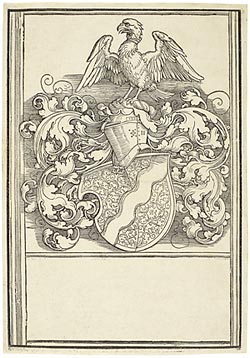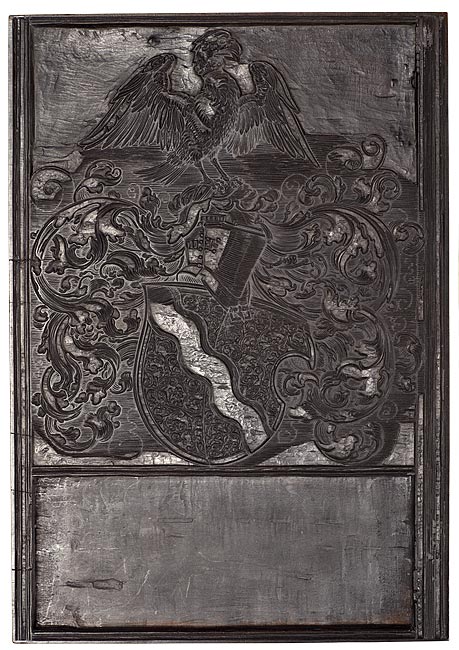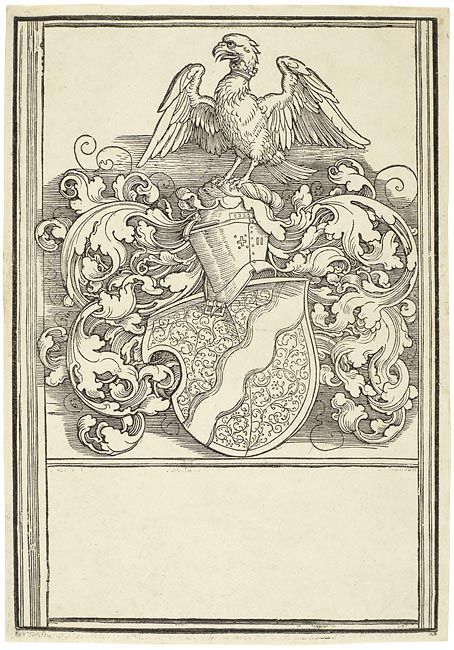This post was created by Mary Broadway, Sherman Fairchild Post Graduate Fellow in Paper Conservation.

Woodcut printed in black ink on laid paper 2008.61
Woodcut
The woodcut, one of the earliest printmaking techniques, became popular in Europe around 1400. Woodcuts are produced by carving an image into a block of wood, usually a hard fruitwood, cut parallel to its grain. Only the lines and shapes of the drawn design are left standing in relief; all other areas of the wood are carefully excised with sharp woodworking tools, such as gouges, chisels, and knives. A viscous ink, which would in Dürer's time have been composed of finely ground lampblack and oil, is applied to the raised surface by dabbing or by rolling with a brayer. The image is then transferred onto a sheet of paper, either manually, by rubbing it against the inked surface of the block, or, mechanically, by the use of a printing press. The image on the block appears in reverse on the page.
The difficulty of cutting the woodblock and the likelihood that the lines would break down with repeated printings meant that early woodcuts were characterized by crude, thick lines without much shading or texture. Albrecht Dürer transformed woodblock printing through the use of fine, graceful lines, intricate details, and subtle gradations, efforts that could be achieved only through skillful and precise carving.
Woodblock
While Dürer's key role in designing woodcuts is certain, his involvement in cutting the blocks can be debated. With the exception of printmaker Albrecht Altdorfer, it was general practice for German artists of the period to design the woodblock but assign the actual carving to a professional woodcutter. The letter pasted to the back of the Behaim block, in which Dürer asserts creative control, suggests that his contribution was the design only. This supposition is strengthened by technical examinations of other extant woodblocks for Dürer prints, such as those for the Little Passion in the British Museum, which betray the hands of four different professional woodcutters.

Albrecht Dürer (1471–1528) Original woodblock for his woodcut Coat of Arms of Michael Behaim AZ127
However, a noteworthy passage in Dürer's theoretical writings implies that he may have cut the blocks himself: "Thus it comes that a man may draw something with his pen on a half-sheet of paper in one day, or dig something in a little piece of wood with his tool, that will be finer and better than any big thing by another who industriously worked a whole year at it." This statement has been used by scholars to suggest that Dürer was, at times, both inventor and executor of his woodblock prints. But without any firm documentary evidence, the question of Dürer's status as woodcutter may never be answered.
Only a few of Dürer's woodblocks survive. A close examination of the woodblock used to create the print The Coat of Arms of Michael Behaim provides insight into the carving process.
The patterns of toolmarks seen in the woodblock speak to the specific chisels, gouges, and knives used to attain particular effects. Short repetitious passes with such tools create distinctive textures in some of the recessed areas of the woodblock. For example, the marks in the large blank areas at the top and bottom of the block are typically made by larger-sized chisels and flat gouges, while the toolmarks around the design's fine lines indicate the use of small, sharp chisels. Highly skilled carving was especially necessary to realize the shield's curvilinear floral pattern. (The rectangular open space at the bottom of the block is for the insertion and printing of movable type, which could be edited easily.)
Thin lines of raised wood are vulnerable to breaking over time from the repeated pressure of printing. The small breaks visible at the lower right edge of the woodblock translate into an interrupted, lighter line in the print.


A side-by-side examination of the woodblock and the print demonstrate the complexity of the carving involved in translating Dürer's sophisticated design into a masterful print.
This post was created in conjunction with the exhibition Defining Beauty: Albrecht Dürer at the Morgan on view May 14 through September 12, 2010.
